Feminist Perspective on Gender and Crime: A Critical Analysis
VerifiedAdded on 2023/06/15
|10
|2715
|182
AI Summary
This article discusses the feminist perspective on gender and crime, highlighting the discrimination against women in the criminal justice system. It critically evaluates this perspective and discusses the criticisms of this approach. The article also highlights the intersectional approach to gender, race, and class.
Contribute Materials
Your contribution can guide someone’s learning journey. Share your
documents today.

Secure Best Marks with AI Grader
Need help grading? Try our AI Grader for instant feedback on your assignments.
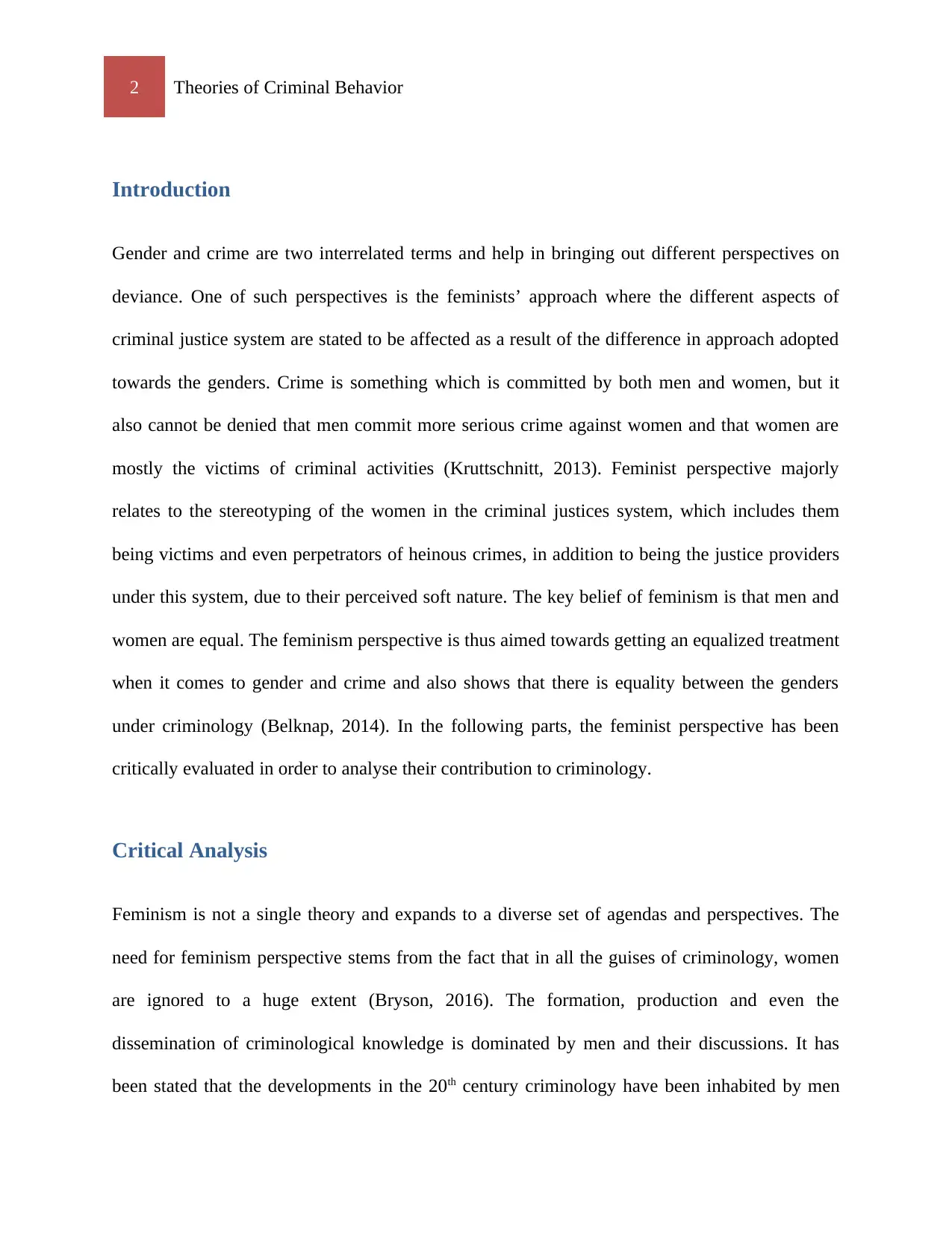
2 Theories of Criminal Behavior
Introduction
Gender and crime are two interrelated terms and help in bringing out different perspectives on
deviance. One of such perspectives is the feminists’ approach where the different aspects of
criminal justice system are stated to be affected as a result of the difference in approach adopted
towards the genders. Crime is something which is committed by both men and women, but it
also cannot be denied that men commit more serious crime against women and that women are
mostly the victims of criminal activities (Kruttschnitt, 2013). Feminist perspective majorly
relates to the stereotyping of the women in the criminal justices system, which includes them
being victims and even perpetrators of heinous crimes, in addition to being the justice providers
under this system, due to their perceived soft nature. The key belief of feminism is that men and
women are equal. The feminism perspective is thus aimed towards getting an equalized treatment
when it comes to gender and crime and also shows that there is equality between the genders
under criminology (Belknap, 2014). In the following parts, the feminist perspective has been
critically evaluated in order to analyse their contribution to criminology.
Critical Analysis
Feminism is not a single theory and expands to a diverse set of agendas and perspectives. The
need for feminism perspective stems from the fact that in all the guises of criminology, women
are ignored to a huge extent (Bryson, 2016). The formation, production and even the
dissemination of criminological knowledge is dominated by men and their discussions. It has
been stated that the developments in the 20th century criminology have been inhabited by men
Introduction
Gender and crime are two interrelated terms and help in bringing out different perspectives on
deviance. One of such perspectives is the feminists’ approach where the different aspects of
criminal justice system are stated to be affected as a result of the difference in approach adopted
towards the genders. Crime is something which is committed by both men and women, but it
also cannot be denied that men commit more serious crime against women and that women are
mostly the victims of criminal activities (Kruttschnitt, 2013). Feminist perspective majorly
relates to the stereotyping of the women in the criminal justices system, which includes them
being victims and even perpetrators of heinous crimes, in addition to being the justice providers
under this system, due to their perceived soft nature. The key belief of feminism is that men and
women are equal. The feminism perspective is thus aimed towards getting an equalized treatment
when it comes to gender and crime and also shows that there is equality between the genders
under criminology (Belknap, 2014). In the following parts, the feminist perspective has been
critically evaluated in order to analyse their contribution to criminology.
Critical Analysis
Feminism is not a single theory and expands to a diverse set of agendas and perspectives. The
need for feminism perspective stems from the fact that in all the guises of criminology, women
are ignored to a huge extent (Bryson, 2016). The formation, production and even the
dissemination of criminological knowledge is dominated by men and their discussions. It has
been stated that the developments in the 20th century criminology have been inhabited by men
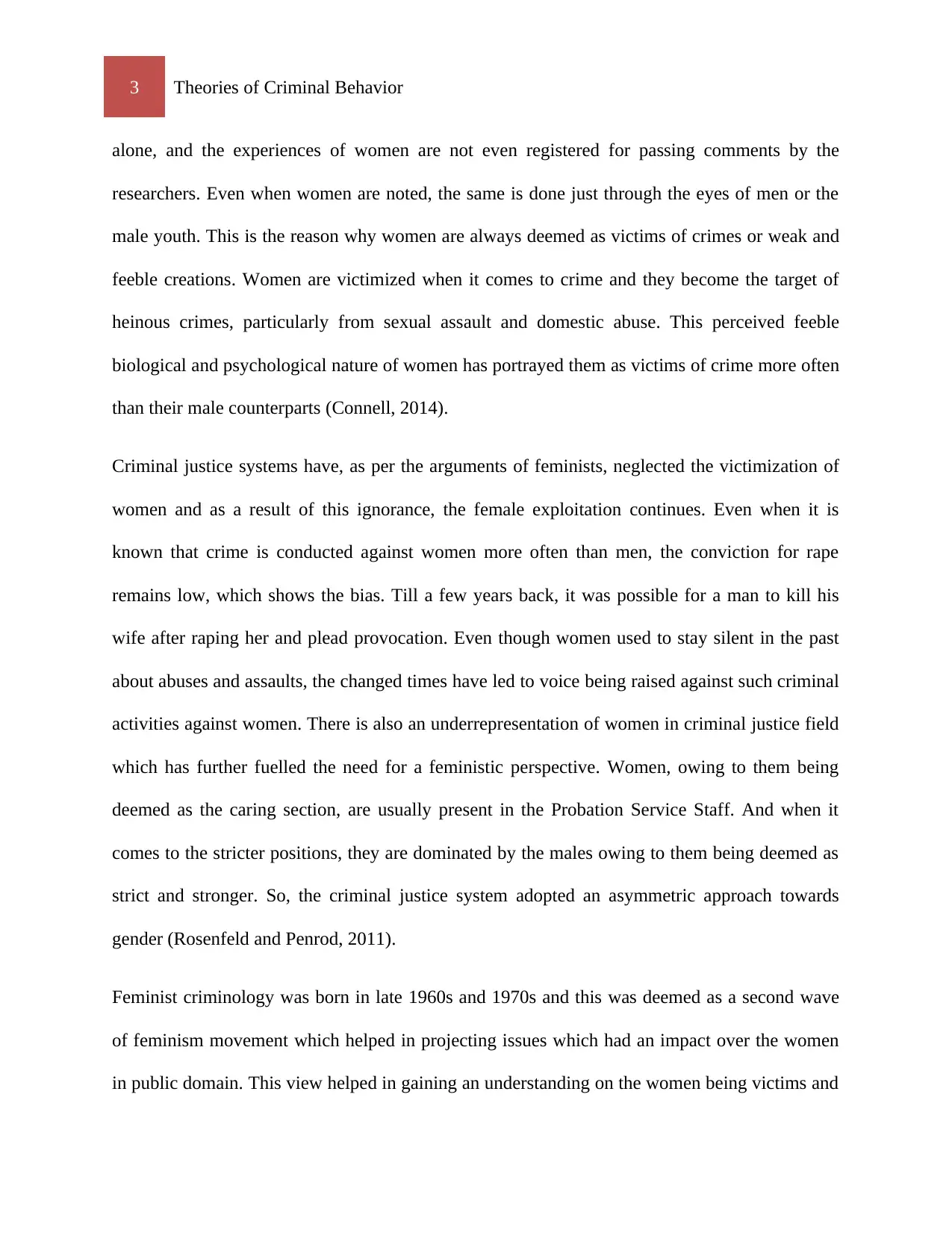
3 Theories of Criminal Behavior
alone, and the experiences of women are not even registered for passing comments by the
researchers. Even when women are noted, the same is done just through the eyes of men or the
male youth. This is the reason why women are always deemed as victims of crimes or weak and
feeble creations. Women are victimized when it comes to crime and they become the target of
heinous crimes, particularly from sexual assault and domestic abuse. This perceived feeble
biological and psychological nature of women has portrayed them as victims of crime more often
than their male counterparts (Connell, 2014).
Criminal justice systems have, as per the arguments of feminists, neglected the victimization of
women and as a result of this ignorance, the female exploitation continues. Even when it is
known that crime is conducted against women more often than men, the conviction for rape
remains low, which shows the bias. Till a few years back, it was possible for a man to kill his
wife after raping her and plead provocation. Even though women used to stay silent in the past
about abuses and assaults, the changed times have led to voice being raised against such criminal
activities against women. There is also an underrepresentation of women in criminal justice field
which has further fuelled the need for a feministic perspective. Women, owing to them being
deemed as the caring section, are usually present in the Probation Service Staff. And when it
comes to the stricter positions, they are dominated by the males owing to them being deemed as
strict and stronger. So, the criminal justice system adopted an asymmetric approach towards
gender (Rosenfeld and Penrod, 2011).
Feminist criminology was born in late 1960s and 1970s and this was deemed as a second wave
of feminism movement which helped in projecting issues which had an impact over the women
in public domain. This view helped in gaining an understanding on the women being victims and
alone, and the experiences of women are not even registered for passing comments by the
researchers. Even when women are noted, the same is done just through the eyes of men or the
male youth. This is the reason why women are always deemed as victims of crimes or weak and
feeble creations. Women are victimized when it comes to crime and they become the target of
heinous crimes, particularly from sexual assault and domestic abuse. This perceived feeble
biological and psychological nature of women has portrayed them as victims of crime more often
than their male counterparts (Connell, 2014).
Criminal justice systems have, as per the arguments of feminists, neglected the victimization of
women and as a result of this ignorance, the female exploitation continues. Even when it is
known that crime is conducted against women more often than men, the conviction for rape
remains low, which shows the bias. Till a few years back, it was possible for a man to kill his
wife after raping her and plead provocation. Even though women used to stay silent in the past
about abuses and assaults, the changed times have led to voice being raised against such criminal
activities against women. There is also an underrepresentation of women in criminal justice field
which has further fuelled the need for a feministic perspective. Women, owing to them being
deemed as the caring section, are usually present in the Probation Service Staff. And when it
comes to the stricter positions, they are dominated by the males owing to them being deemed as
strict and stronger. So, the criminal justice system adopted an asymmetric approach towards
gender (Rosenfeld and Penrod, 2011).
Feminist criminology was born in late 1960s and 1970s and this was deemed as a second wave
of feminism movement which helped in projecting issues which had an impact over the women
in public domain. This view helped in gaining an understanding on the women being victims and
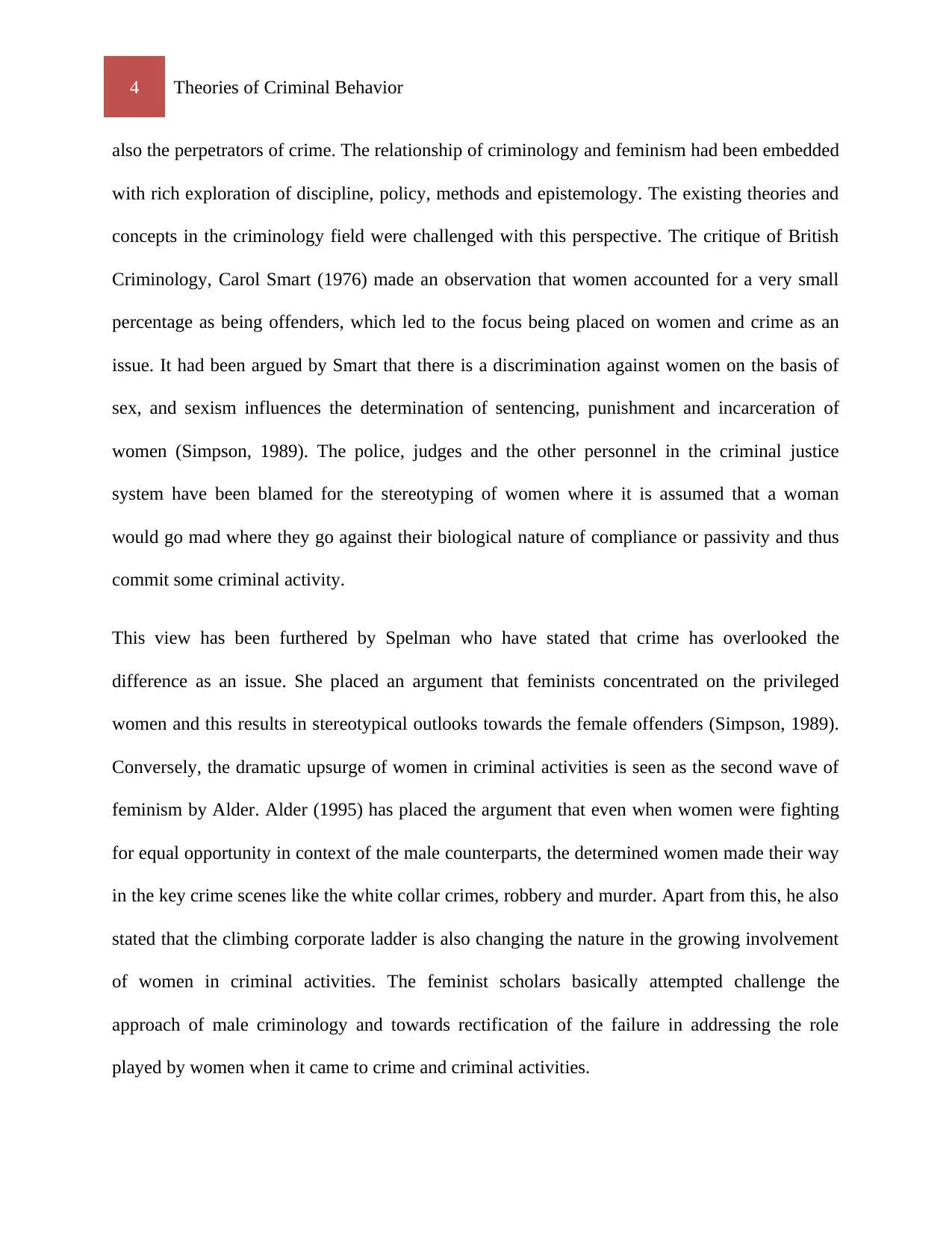
4 Theories of Criminal Behavior
also the perpetrators of crime. The relationship of criminology and feminism had been embedded
with rich exploration of discipline, policy, methods and epistemology. The existing theories and
concepts in the criminology field were challenged with this perspective. The critique of British
Criminology, Carol Smart (1976) made an observation that women accounted for a very small
percentage as being offenders, which led to the focus being placed on women and crime as an
issue. It had been argued by Smart that there is a discrimination against women on the basis of
sex, and sexism influences the determination of sentencing, punishment and incarceration of
women (Simpson, 1989). The police, judges and the other personnel in the criminal justice
system have been blamed for the stereotyping of women where it is assumed that a woman
would go mad where they go against their biological nature of compliance or passivity and thus
commit some criminal activity.
This view has been furthered by Spelman who have stated that crime has overlooked the
difference as an issue. She placed an argument that feminists concentrated on the privileged
women and this results in stereotypical outlooks towards the female offenders (Simpson, 1989).
Conversely, the dramatic upsurge of women in criminal activities is seen as the second wave of
feminism by Alder. Alder (1995) has placed the argument that even when women were fighting
for equal opportunity in context of the male counterparts, the determined women made their way
in the key crime scenes like the white collar crimes, robbery and murder. Apart from this, he also
stated that the climbing corporate ladder is also changing the nature in the growing involvement
of women in criminal activities. The feminist scholars basically attempted challenge the
approach of male criminology and towards rectification of the failure in addressing the role
played by women when it came to crime and criminal activities.
also the perpetrators of crime. The relationship of criminology and feminism had been embedded
with rich exploration of discipline, policy, methods and epistemology. The existing theories and
concepts in the criminology field were challenged with this perspective. The critique of British
Criminology, Carol Smart (1976) made an observation that women accounted for a very small
percentage as being offenders, which led to the focus being placed on women and crime as an
issue. It had been argued by Smart that there is a discrimination against women on the basis of
sex, and sexism influences the determination of sentencing, punishment and incarceration of
women (Simpson, 1989). The police, judges and the other personnel in the criminal justice
system have been blamed for the stereotyping of women where it is assumed that a woman
would go mad where they go against their biological nature of compliance or passivity and thus
commit some criminal activity.
This view has been furthered by Spelman who have stated that crime has overlooked the
difference as an issue. She placed an argument that feminists concentrated on the privileged
women and this results in stereotypical outlooks towards the female offenders (Simpson, 1989).
Conversely, the dramatic upsurge of women in criminal activities is seen as the second wave of
feminism by Alder. Alder (1995) has placed the argument that even when women were fighting
for equal opportunity in context of the male counterparts, the determined women made their way
in the key crime scenes like the white collar crimes, robbery and murder. Apart from this, he also
stated that the climbing corporate ladder is also changing the nature in the growing involvement
of women in criminal activities. The feminist scholars basically attempted challenge the
approach of male criminology and towards rectification of the failure in addressing the role
played by women when it came to crime and criminal activities.
Secure Best Marks with AI Grader
Need help grading? Try our AI Grader for instant feedback on your assignments.
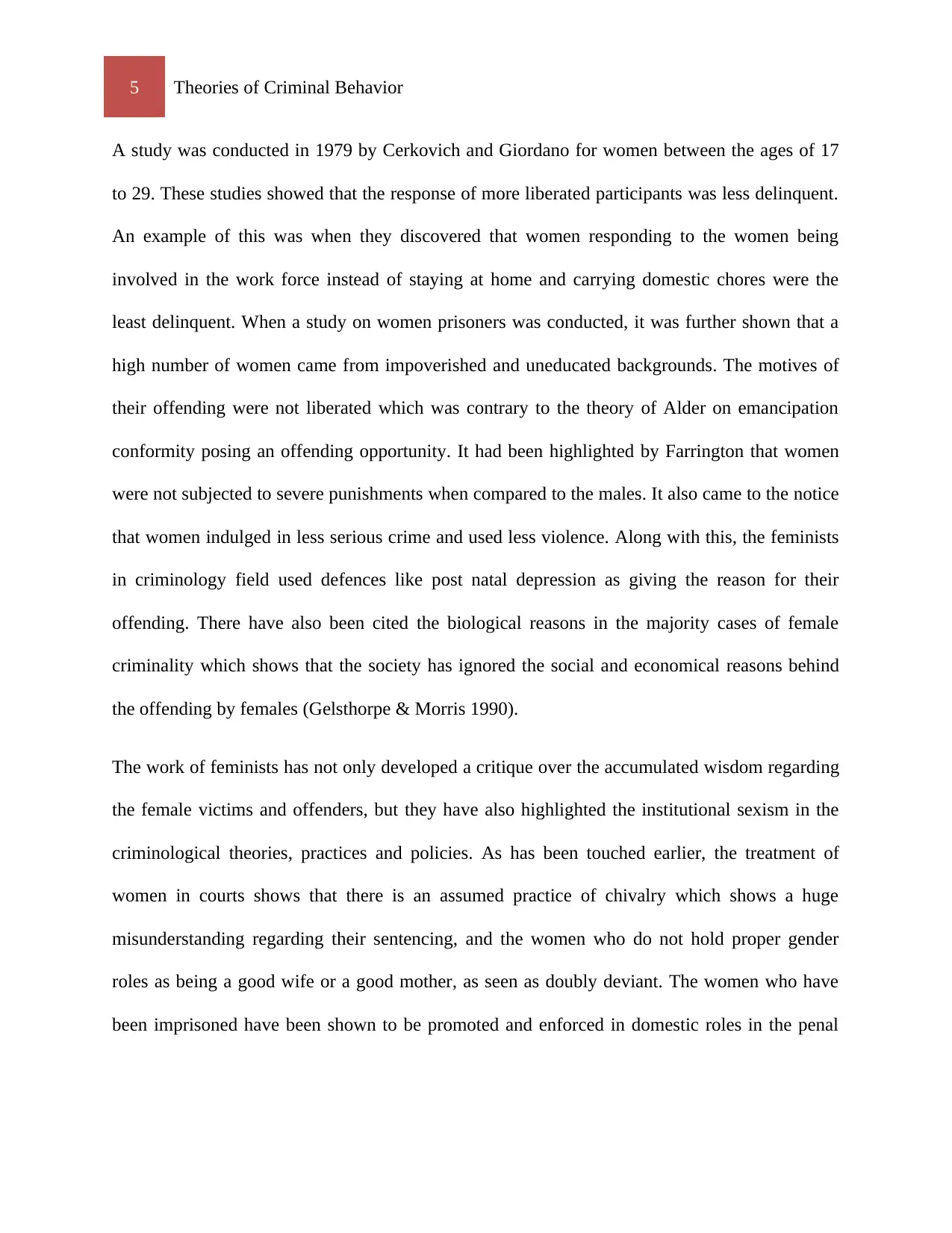
5 Theories of Criminal Behavior
A study was conducted in 1979 by Cerkovich and Giordano for women between the ages of 17
to 29. These studies showed that the response of more liberated participants was less delinquent.
An example of this was when they discovered that women responding to the women being
involved in the work force instead of staying at home and carrying domestic chores were the
least delinquent. When a study on women prisoners was conducted, it was further shown that a
high number of women came from impoverished and uneducated backgrounds. The motives of
their offending were not liberated which was contrary to the theory of Alder on emancipation
conformity posing an offending opportunity. It had been highlighted by Farrington that women
were not subjected to severe punishments when compared to the males. It also came to the notice
that women indulged in less serious crime and used less violence. Along with this, the feminists
in criminology field used defences like post natal depression as giving the reason for their
offending. There have also been cited the biological reasons in the majority cases of female
criminality which shows that the society has ignored the social and economical reasons behind
the offending by females (Gelsthorpe & Morris 1990).
The work of feminists has not only developed a critique over the accumulated wisdom regarding
the female victims and offenders, but they have also highlighted the institutional sexism in the
criminological theories, practices and policies. As has been touched earlier, the treatment of
women in courts shows that there is an assumed practice of chivalry which shows a huge
misunderstanding regarding their sentencing, and the women who do not hold proper gender
roles as being a good wife or a good mother, as seen as doubly deviant. The women who have
been imprisoned have been shown to be promoted and enforced in domestic roles in the penal
A study was conducted in 1979 by Cerkovich and Giordano for women between the ages of 17
to 29. These studies showed that the response of more liberated participants was less delinquent.
An example of this was when they discovered that women responding to the women being
involved in the work force instead of staying at home and carrying domestic chores were the
least delinquent. When a study on women prisoners was conducted, it was further shown that a
high number of women came from impoverished and uneducated backgrounds. The motives of
their offending were not liberated which was contrary to the theory of Alder on emancipation
conformity posing an offending opportunity. It had been highlighted by Farrington that women
were not subjected to severe punishments when compared to the males. It also came to the notice
that women indulged in less serious crime and used less violence. Along with this, the feminists
in criminology field used defences like post natal depression as giving the reason for their
offending. There have also been cited the biological reasons in the majority cases of female
criminality which shows that the society has ignored the social and economical reasons behind
the offending by females (Gelsthorpe & Morris 1990).
The work of feminists has not only developed a critique over the accumulated wisdom regarding
the female victims and offenders, but they have also highlighted the institutional sexism in the
criminological theories, practices and policies. As has been touched earlier, the treatment of
women in courts shows that there is an assumed practice of chivalry which shows a huge
misunderstanding regarding their sentencing, and the women who do not hold proper gender
roles as being a good wife or a good mother, as seen as doubly deviant. The women who have
been imprisoned have been shown to be promoted and enforced in domestic roles in the penal
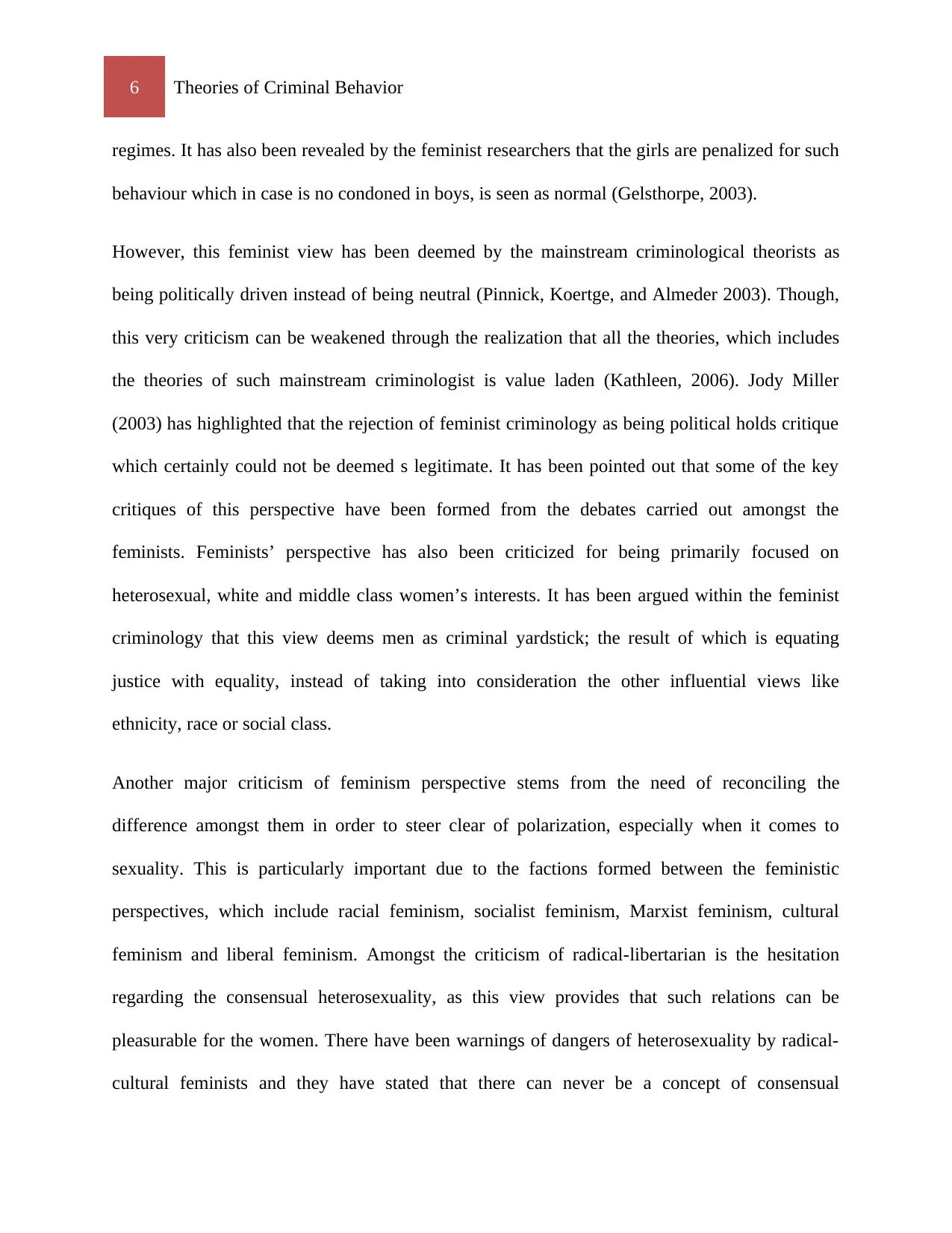
6 Theories of Criminal Behavior
regimes. It has also been revealed by the feminist researchers that the girls are penalized for such
behaviour which in case is no condoned in boys, is seen as normal (Gelsthorpe, 2003).
However, this feminist view has been deemed by the mainstream criminological theorists as
being politically driven instead of being neutral (Pinnick, Koertge, and Almeder 2003). Though,
this very criticism can be weakened through the realization that all the theories, which includes
the theories of such mainstream criminologist is value laden (Kathleen, 2006). Jody Miller
(2003) has highlighted that the rejection of feminist criminology as being political holds critique
which certainly could not be deemed s legitimate. It has been pointed out that some of the key
critiques of this perspective have been formed from the debates carried out amongst the
feminists. Feminists’ perspective has also been criticized for being primarily focused on
heterosexual, white and middle class women’s interests. It has been argued within the feminist
criminology that this view deems men as criminal yardstick; the result of which is equating
justice with equality, instead of taking into consideration the other influential views like
ethnicity, race or social class.
Another major criticism of feminism perspective stems from the need of reconciling the
difference amongst them in order to steer clear of polarization, especially when it comes to
sexuality. This is particularly important due to the factions formed between the feministic
perspectives, which include racial feminism, socialist feminism, Marxist feminism, cultural
feminism and liberal feminism. Amongst the criticism of radical-libertarian is the hesitation
regarding the consensual heterosexuality, as this view provides that such relations can be
pleasurable for the women. There have been warnings of dangers of heterosexuality by radical-
cultural feminists and they have stated that there can never be a concept of consensual
regimes. It has also been revealed by the feminist researchers that the girls are penalized for such
behaviour which in case is no condoned in boys, is seen as normal (Gelsthorpe, 2003).
However, this feminist view has been deemed by the mainstream criminological theorists as
being politically driven instead of being neutral (Pinnick, Koertge, and Almeder 2003). Though,
this very criticism can be weakened through the realization that all the theories, which includes
the theories of such mainstream criminologist is value laden (Kathleen, 2006). Jody Miller
(2003) has highlighted that the rejection of feminist criminology as being political holds critique
which certainly could not be deemed s legitimate. It has been pointed out that some of the key
critiques of this perspective have been formed from the debates carried out amongst the
feminists. Feminists’ perspective has also been criticized for being primarily focused on
heterosexual, white and middle class women’s interests. It has been argued within the feminist
criminology that this view deems men as criminal yardstick; the result of which is equating
justice with equality, instead of taking into consideration the other influential views like
ethnicity, race or social class.
Another major criticism of feminism perspective stems from the need of reconciling the
difference amongst them in order to steer clear of polarization, especially when it comes to
sexuality. This is particularly important due to the factions formed between the feministic
perspectives, which include racial feminism, socialist feminism, Marxist feminism, cultural
feminism and liberal feminism. Amongst the criticism of radical-libertarian is the hesitation
regarding the consensual heterosexuality, as this view provides that such relations can be
pleasurable for the women. There have been warnings of dangers of heterosexuality by radical-
cultural feminists and they have stated that there can never be a concept of consensual
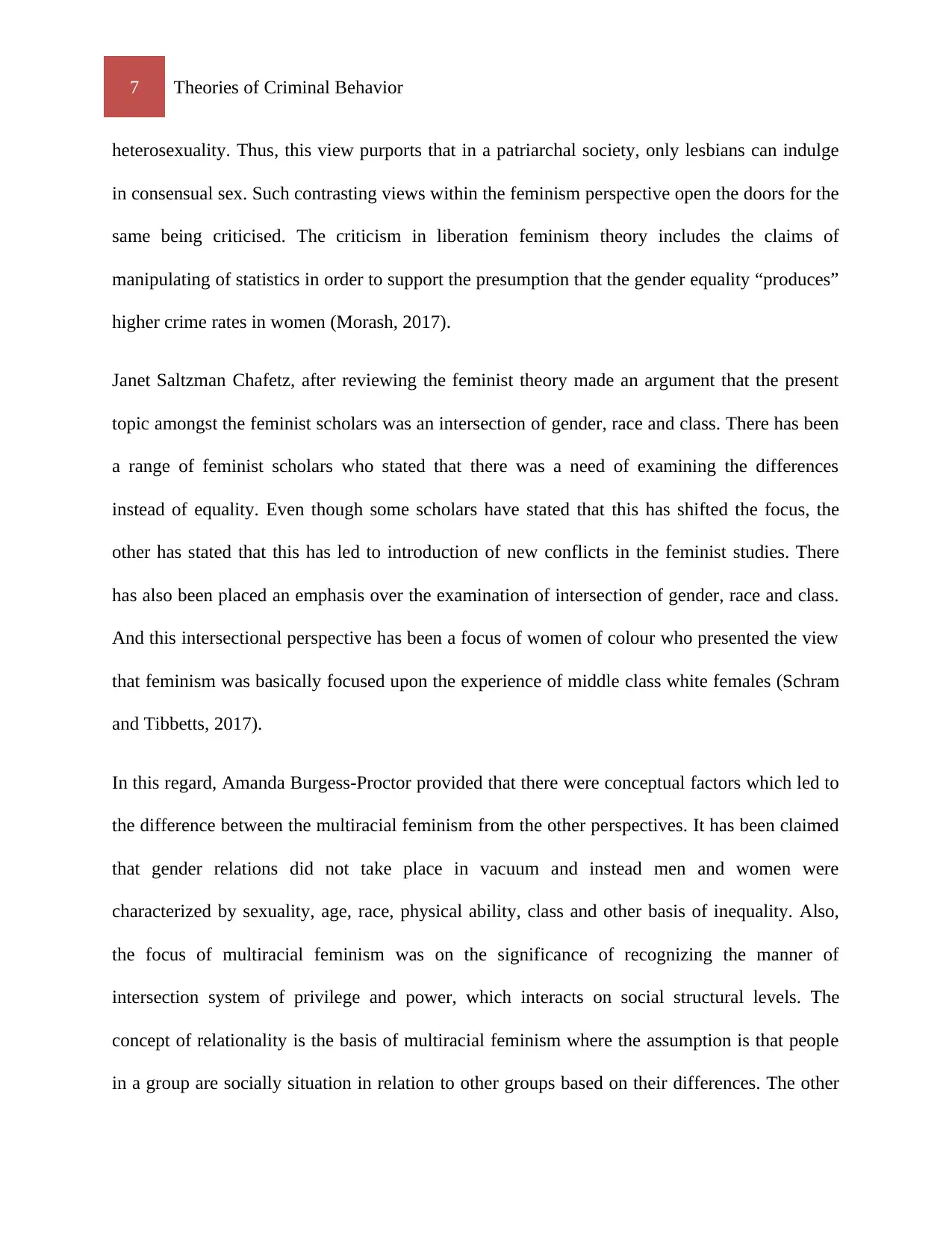
7 Theories of Criminal Behavior
heterosexuality. Thus, this view purports that in a patriarchal society, only lesbians can indulge
in consensual sex. Such contrasting views within the feminism perspective open the doors for the
same being criticised. The criticism in liberation feminism theory includes the claims of
manipulating of statistics in order to support the presumption that the gender equality “produces”
higher crime rates in women (Morash, 2017).
Janet Saltzman Chafetz, after reviewing the feminist theory made an argument that the present
topic amongst the feminist scholars was an intersection of gender, race and class. There has been
a range of feminist scholars who stated that there was a need of examining the differences
instead of equality. Even though some scholars have stated that this has shifted the focus, the
other has stated that this has led to introduction of new conflicts in the feminist studies. There
has also been placed an emphasis over the examination of intersection of gender, race and class.
And this intersectional perspective has been a focus of women of colour who presented the view
that feminism was basically focused upon the experience of middle class white females (Schram
and Tibbetts, 2017).
In this regard, Amanda Burgess-Proctor provided that there were conceptual factors which led to
the difference between the multiracial feminism from the other perspectives. It has been claimed
that gender relations did not take place in vacuum and instead men and women were
characterized by sexuality, age, race, physical ability, class and other basis of inequality. Also,
the focus of multiracial feminism was on the significance of recognizing the manner of
intersection system of privilege and power, which interacts on social structural levels. The
concept of relationality is the basis of multiracial feminism where the assumption is that people
in a group are socially situation in relation to other groups based on their differences. The other
heterosexuality. Thus, this view purports that in a patriarchal society, only lesbians can indulge
in consensual sex. Such contrasting views within the feminism perspective open the doors for the
same being criticised. The criticism in liberation feminism theory includes the claims of
manipulating of statistics in order to support the presumption that the gender equality “produces”
higher crime rates in women (Morash, 2017).
Janet Saltzman Chafetz, after reviewing the feminist theory made an argument that the present
topic amongst the feminist scholars was an intersection of gender, race and class. There has been
a range of feminist scholars who stated that there was a need of examining the differences
instead of equality. Even though some scholars have stated that this has shifted the focus, the
other has stated that this has led to introduction of new conflicts in the feminist studies. There
has also been placed an emphasis over the examination of intersection of gender, race and class.
And this intersectional perspective has been a focus of women of colour who presented the view
that feminism was basically focused upon the experience of middle class white females (Schram
and Tibbetts, 2017).
In this regard, Amanda Burgess-Proctor provided that there were conceptual factors which led to
the difference between the multiracial feminism from the other perspectives. It has been claimed
that gender relations did not take place in vacuum and instead men and women were
characterized by sexuality, age, race, physical ability, class and other basis of inequality. Also,
the focus of multiracial feminism was on the significance of recognizing the manner of
intersection system of privilege and power, which interacts on social structural levels. The
concept of relationality is the basis of multiracial feminism where the assumption is that people
in a group are socially situation in relation to other groups based on their differences. The other
Paraphrase This Document
Need a fresh take? Get an instant paraphrase of this document with our AI Paraphraser
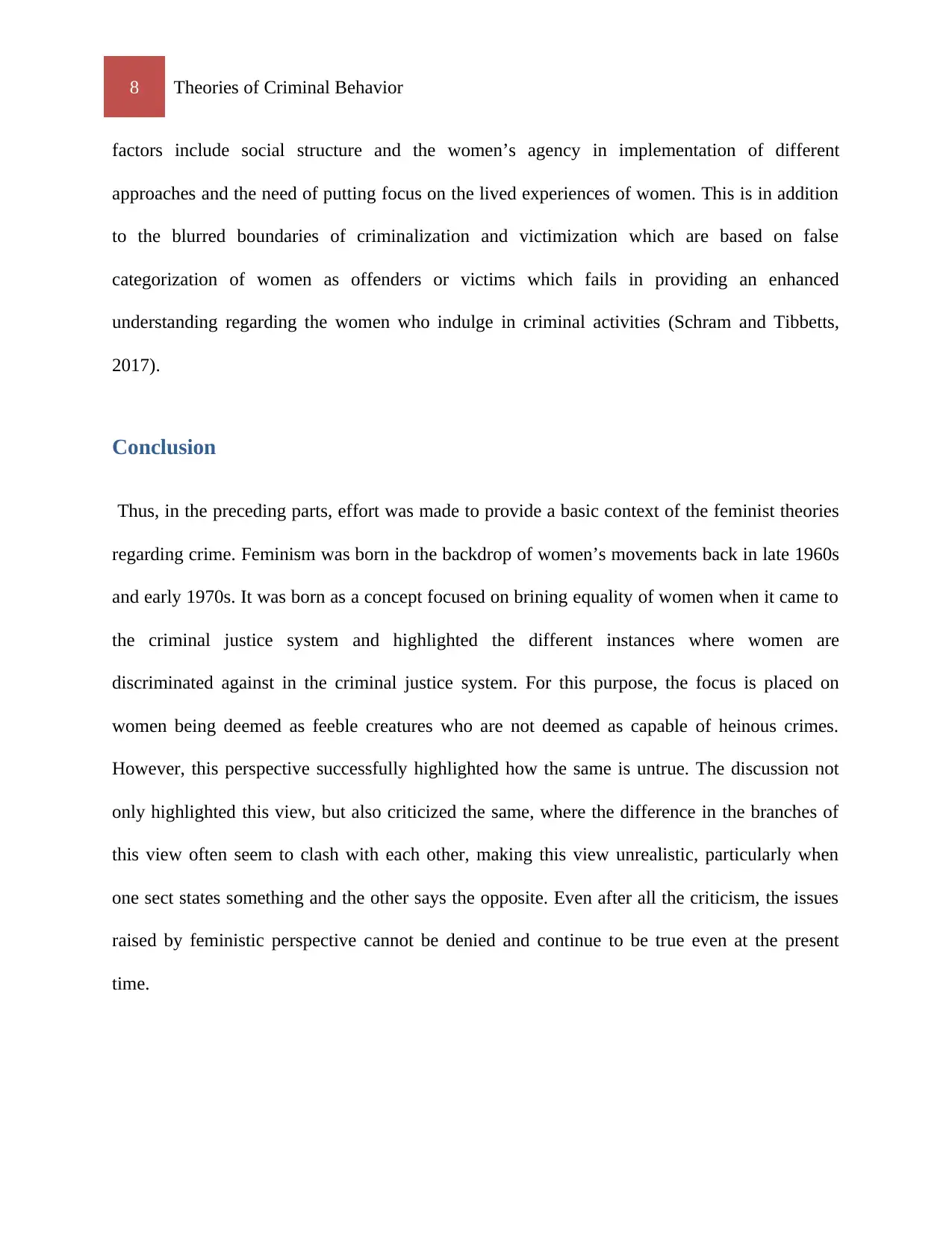
8 Theories of Criminal Behavior
factors include social structure and the women’s agency in implementation of different
approaches and the need of putting focus on the lived experiences of women. This is in addition
to the blurred boundaries of criminalization and victimization which are based on false
categorization of women as offenders or victims which fails in providing an enhanced
understanding regarding the women who indulge in criminal activities (Schram and Tibbetts,
2017).
Conclusion
Thus, in the preceding parts, effort was made to provide a basic context of the feminist theories
regarding crime. Feminism was born in the backdrop of women’s movements back in late 1960s
and early 1970s. It was born as a concept focused on brining equality of women when it came to
the criminal justice system and highlighted the different instances where women are
discriminated against in the criminal justice system. For this purpose, the focus is placed on
women being deemed as feeble creatures who are not deemed as capable of heinous crimes.
However, this perspective successfully highlighted how the same is untrue. The discussion not
only highlighted this view, but also criticized the same, where the difference in the branches of
this view often seem to clash with each other, making this view unrealistic, particularly when
one sect states something and the other says the opposite. Even after all the criticism, the issues
raised by feministic perspective cannot be denied and continue to be true even at the present
time.
factors include social structure and the women’s agency in implementation of different
approaches and the need of putting focus on the lived experiences of women. This is in addition
to the blurred boundaries of criminalization and victimization which are based on false
categorization of women as offenders or victims which fails in providing an enhanced
understanding regarding the women who indulge in criminal activities (Schram and Tibbetts,
2017).
Conclusion
Thus, in the preceding parts, effort was made to provide a basic context of the feminist theories
regarding crime. Feminism was born in the backdrop of women’s movements back in late 1960s
and early 1970s. It was born as a concept focused on brining equality of women when it came to
the criminal justice system and highlighted the different instances where women are
discriminated against in the criminal justice system. For this purpose, the focus is placed on
women being deemed as feeble creatures who are not deemed as capable of heinous crimes.
However, this perspective successfully highlighted how the same is untrue. The discussion not
only highlighted this view, but also criticized the same, where the difference in the branches of
this view often seem to clash with each other, making this view unrealistic, particularly when
one sect states something and the other says the opposite. Even after all the criticism, the issues
raised by feministic perspective cannot be denied and continue to be true even at the present
time.
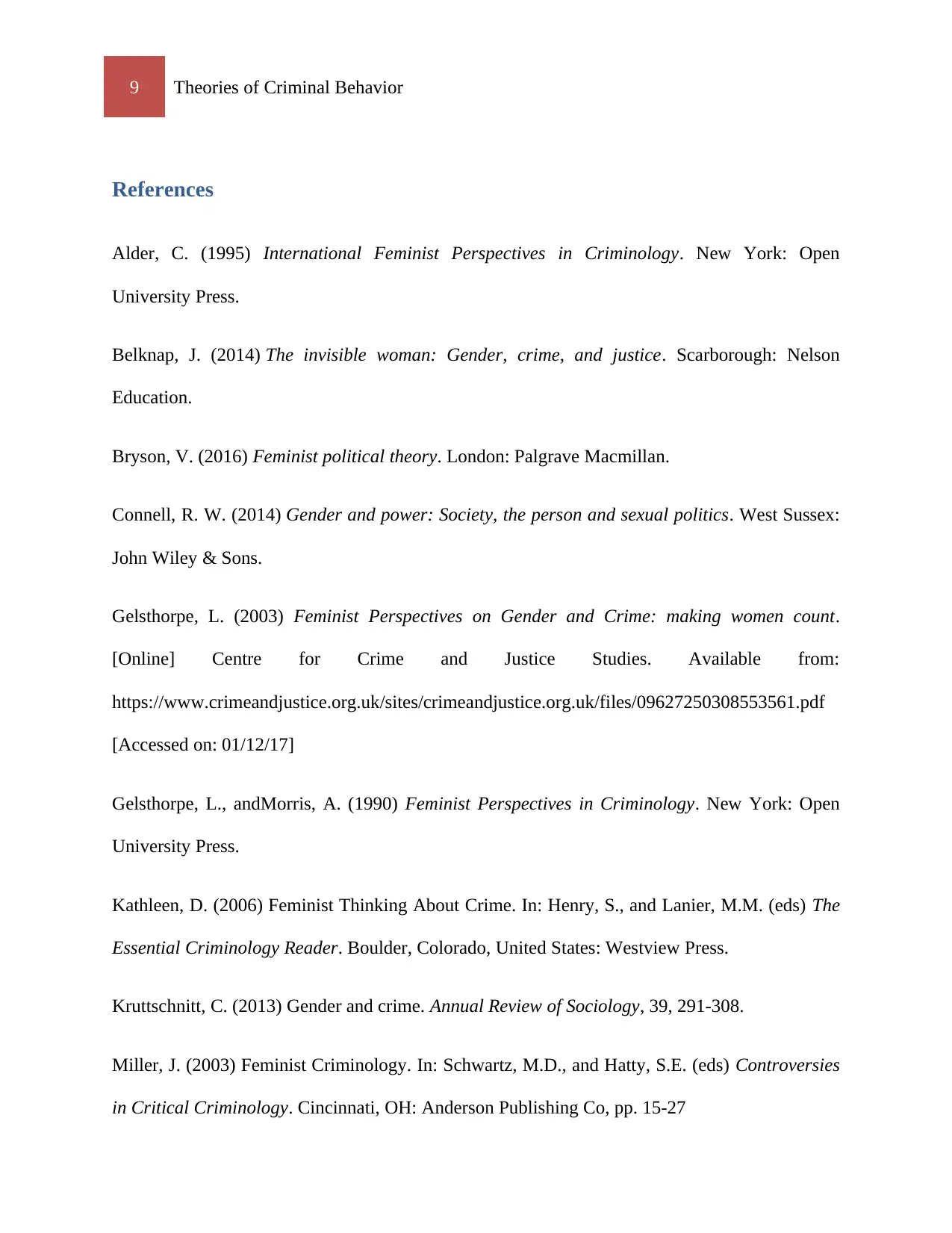
9 Theories of Criminal Behavior
References
Alder, C. (1995) International Feminist Perspectives in Criminology. New York: Open
University Press.
Belknap, J. (2014) The invisible woman: Gender, crime, and justice. Scarborough: Nelson
Education.
Bryson, V. (2016) Feminist political theory. London: Palgrave Macmillan.
Connell, R. W. (2014) Gender and power: Society, the person and sexual politics. West Sussex:
John Wiley & Sons.
Gelsthorpe, L. (2003) Feminist Perspectives on Gender and Crime: making women count.
[Online] Centre for Crime and Justice Studies. Available from:
https://www.crimeandjustice.org.uk/sites/crimeandjustice.org.uk/files/09627250308553561.pdf
[Accessed on: 01/12/17]
Gelsthorpe, L., andMorris, A. (1990) Feminist Perspectives in Criminology. New York: Open
University Press.
Kathleen, D. (2006) Feminist Thinking About Crime. In: Henry, S., and Lanier, M.M. (eds) The
Essential Criminology Reader. Boulder, Colorado, United States: Westview Press.
Kruttschnitt, C. (2013) Gender and crime. Annual Review of Sociology, 39, 291-308.
Miller, J. (2003) Feminist Criminology. In: Schwartz, M.D., and Hatty, S.E. (eds) Controversies
in Critical Criminology. Cincinnati, OH: Anderson Publishing Co, pp. 15-27
References
Alder, C. (1995) International Feminist Perspectives in Criminology. New York: Open
University Press.
Belknap, J. (2014) The invisible woman: Gender, crime, and justice. Scarborough: Nelson
Education.
Bryson, V. (2016) Feminist political theory. London: Palgrave Macmillan.
Connell, R. W. (2014) Gender and power: Society, the person and sexual politics. West Sussex:
John Wiley & Sons.
Gelsthorpe, L. (2003) Feminist Perspectives on Gender and Crime: making women count.
[Online] Centre for Crime and Justice Studies. Available from:
https://www.crimeandjustice.org.uk/sites/crimeandjustice.org.uk/files/09627250308553561.pdf
[Accessed on: 01/12/17]
Gelsthorpe, L., andMorris, A. (1990) Feminist Perspectives in Criminology. New York: Open
University Press.
Kathleen, D. (2006) Feminist Thinking About Crime. In: Henry, S., and Lanier, M.M. (eds) The
Essential Criminology Reader. Boulder, Colorado, United States: Westview Press.
Kruttschnitt, C. (2013) Gender and crime. Annual Review of Sociology, 39, 291-308.
Miller, J. (2003) Feminist Criminology. In: Schwartz, M.D., and Hatty, S.E. (eds) Controversies
in Critical Criminology. Cincinnati, OH: Anderson Publishing Co, pp. 15-27
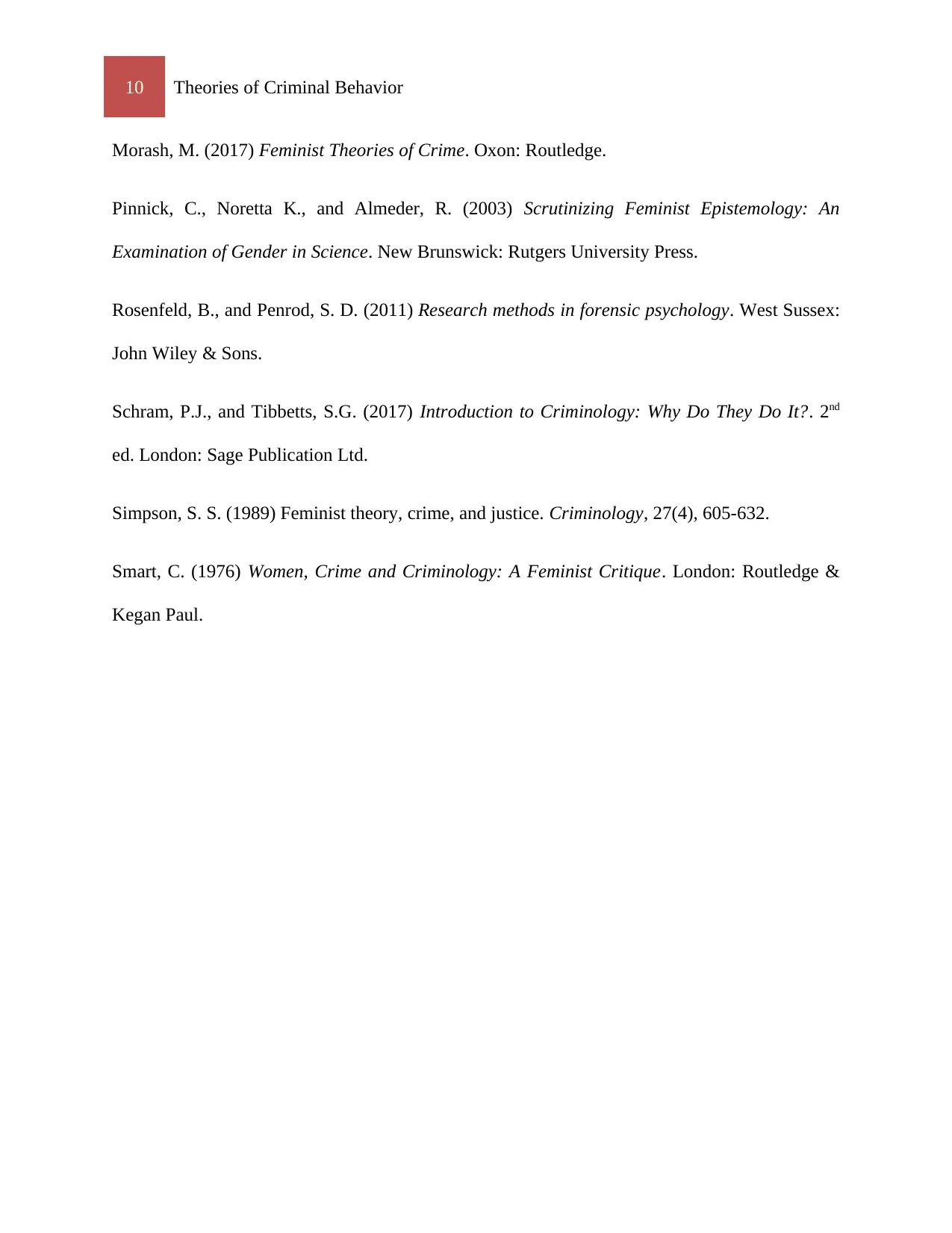
10 Theories of Criminal Behavior
Morash, M. (2017) Feminist Theories of Crime. Oxon: Routledge.
Pinnick, C., Noretta K., and Almeder, R. (2003) Scrutinizing Feminist Epistemology: An
Examination of Gender in Science. New Brunswick: Rutgers University Press.
Rosenfeld, B., and Penrod, S. D. (2011) Research methods in forensic psychology. West Sussex:
John Wiley & Sons.
Schram, P.J., and Tibbetts, S.G. (2017) Introduction to Criminology: Why Do They Do It?. 2nd
ed. London: Sage Publication Ltd.
Simpson, S. S. (1989) Feminist theory, crime, and justice. Criminology, 27(4), 605-632.
Smart, C. (1976) Women, Crime and Criminology: A Feminist Critique. London: Routledge &
Kegan Paul.
Morash, M. (2017) Feminist Theories of Crime. Oxon: Routledge.
Pinnick, C., Noretta K., and Almeder, R. (2003) Scrutinizing Feminist Epistemology: An
Examination of Gender in Science. New Brunswick: Rutgers University Press.
Rosenfeld, B., and Penrod, S. D. (2011) Research methods in forensic psychology. West Sussex:
John Wiley & Sons.
Schram, P.J., and Tibbetts, S.G. (2017) Introduction to Criminology: Why Do They Do It?. 2nd
ed. London: Sage Publication Ltd.
Simpson, S. S. (1989) Feminist theory, crime, and justice. Criminology, 27(4), 605-632.
Smart, C. (1976) Women, Crime and Criminology: A Feminist Critique. London: Routledge &
Kegan Paul.
1 out of 10
Related Documents
Your All-in-One AI-Powered Toolkit for Academic Success.
+13062052269
info@desklib.com
Available 24*7 on WhatsApp / Email
![[object Object]](/_next/static/media/star-bottom.7253800d.svg)
Unlock your academic potential
© 2024 | Zucol Services PVT LTD | All rights reserved.





